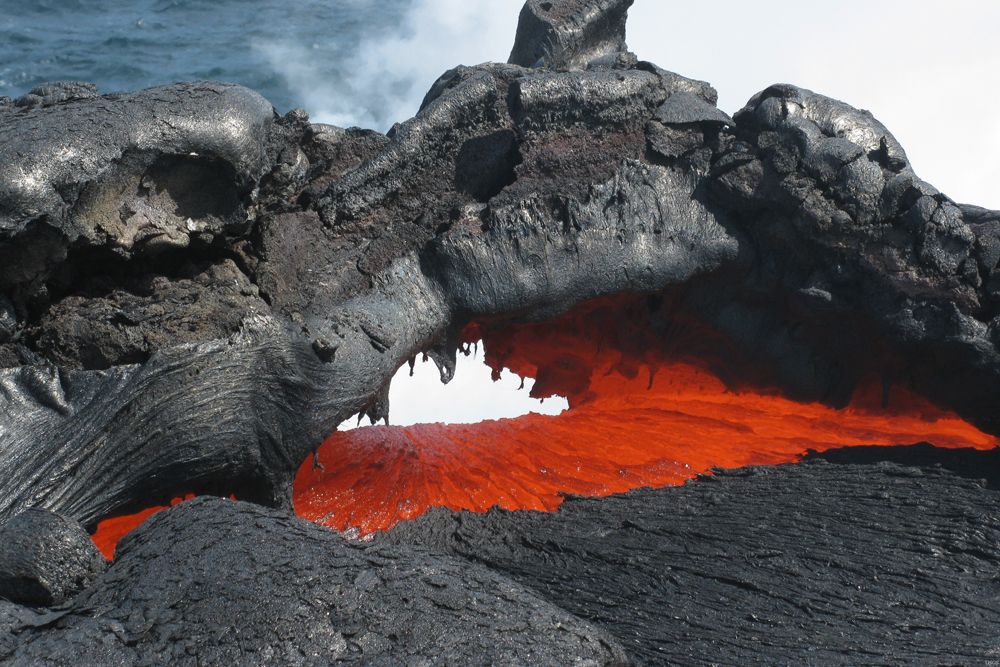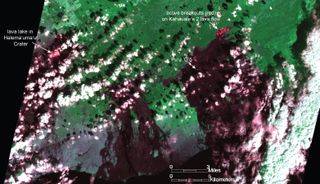
Hello, Hot Stuff! New Hawaii Magma Source Found

Hawaii's Kilauea volcano conceals a deeply buried magma chamber beneath its East Rift Zone, where lava hasn't stopped streaming from the surface for 31 years, a new study reports.
The chamber's molten mush, about 90 percent crystal and 10 percent magma, sits in oceanic crust about 5 to 7 miles (8 to 11 kilometers) beneath Kilauea's south slopes, researchers report Jan. 10 in the journal Geology. The deep magma system may help lubricate the volcano's ongoing collapse into the ocean, the authors report.
"This work could change our thoughts about how [the] Kilauea volcano works, as no deep magma chambers have been observed before," said Guoqing Lin, lead study author and a geophysicist at the University of Miami's Rosenstiel School of Marine and Atmospheric Science in Florida. "Although the shallow part of [Kilauea] is fairly well understood, the deep part is still a mystery to us."
Lin and her co-authors think the deep crustal reservoir could be the source of magma that is pushing Kilauea's broad southern slopes toward the sea. [Explosive Images: Hawaii's Kilauea Erupts for 30 Years]
Falling to pieces
Since a powerful magnitude-7.2 earthquake rattled Kilauea on Nov. 29, 1975, scientists have suspected that Kilauea's East Rift Zone — a broad ridge that extends from the volcano's summit to the ocean floor — sits atop a magma blob. For years before the earthquake, volcano watchers had tracked Kilauea's southern slopes moving toward the sea. But after the quake, the south slope of Kilauea started sliding even faster, like it was sitting on top of an inflating balloon.
Researchers proposed that magma rising beneath the volcano was pushing the volcano's slopes outward. Because the surface changes were so broad, the magma source must be deep, the researchers thought. Earlier research suggested the rising magma was probably about 2.5 miles (4 km) below the surface. The new study indicates this molten core may extend even farther below the volcano, into the deep reservoir identified by Lin and her colleagues.
Sign up for the Live Science daily newsletter now
Get the world’s most fascinating discoveries delivered straight to your inbox.
"This reservoir could have supplied the magma that intruded into the deep section of the East Rift Zone and caused its rapid expansion following the 1975 Kalapana earthquake," Lin told Live Science.

Lin and her co-authors discovered the hidden magma by analyzing earthquake waves. Geoscientists measure the different speeds of seismic waves in rocks and magma to create pictures of Earth's insides, similar to how medical CT scans work. (One type of seismic wave, called an S-wave, goes missing or is extremely slow in liquid.)
Earthquakes and other measurements have also revealed that the ongoing eruption in Kilauea's East Rift Zone is fed by shallow intrusions and eruptions of magma that move in narrow, knifelike fractures called dikes. The dikes are in the upper part of the volcano, about 1 to 2.5 miles (2 to 4 km) below the surface.
Mapping all of Kilauea's underground plumbing has long been a goal of geoscientists, both for understanding the volcano and better predicting its future hazards.
"Understanding these magma bodies [is] a high priority, because of the hazard posed by the volcano," said Falk Amelung, study co-author and a geophysicist at the University of Miami.
Email Becky Oskin or follow her @beckyoskin. Follow us @OAPlanet, Facebook and Google+. Original article at Live Science's Our Amazing Planet.












